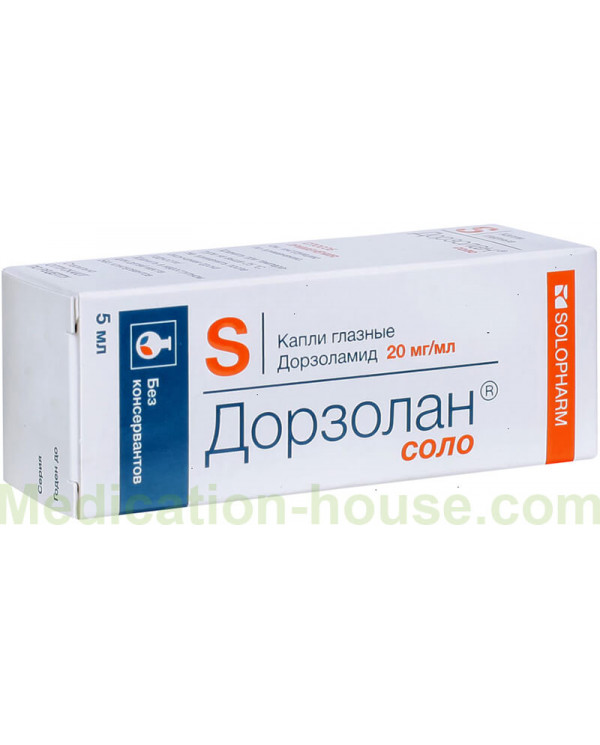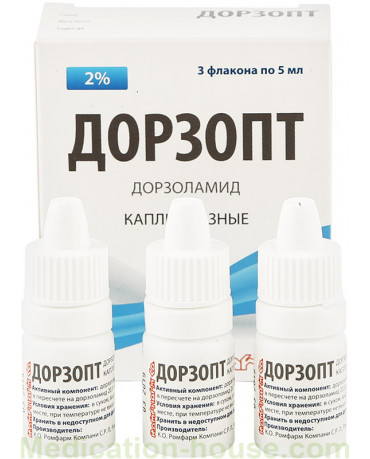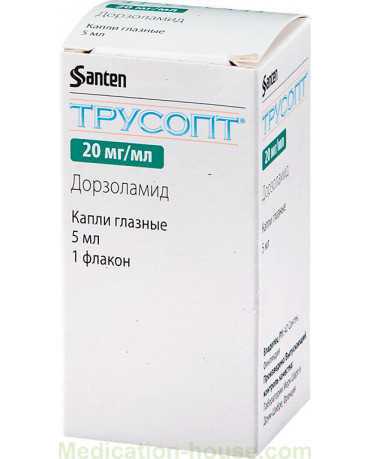Instruction for Dorzolan Solo
Reed more and buy Dorzolan Solo on this page
Dorzolan Solo is a carbonic anhydrase inhibitor, an antiglaucoma drug for topical use in ophthalmology.
Release form and composition
The drug is available in the form of eye drops: a clear liquid with a slightly viscous structure, colorless or almost colorless (0.4 ml each in polyethylene or polypropylene tube-droppers: 5 tube-droppers in a package, in a cardboard box 2, 4, 6, 12 or 18 bags; 10 dropper tubes per bag, in a cardboard box 1, 2, 3, 6 or 9 bags; in a cardboard box 10, 20, 30, 60 or 90 dropper tubes; 5, 7 or 10 ml per plastic vials, complete with a drop dispenser, in a cardboard box 1 bottle; each box also contains instructions for the use of Dorzolan solo).
1 ml of drops contains:
active substance: dorzolamide hydrochloride - 22.26 mg, which in terms of dorzolamide is 20 mg;
auxiliary components: mannitol, sodium citrate dihydrate, 1M sodium hydroxide solution, sodium hyaluronate, water for injection.
Pharmacodynamics
Dorzolan Solo is an antiglaucoma drug in the form of eye drops, the active ingredient of which is a carbonic anhydrase II inhibitor - dorzolamide hydrochloride.
The mechanism of action of the solution is due to the inhibition of carbonic anhydrase in the ciliary body of the eyeball, which causes a decrease in the production of intraocular fluid. It is assumed that the elimination of fluid occurs due to the slowing down of the synthesis of bicarbonate ions and their subsequent reduction to sodium. This helps to lower intraocular pressure.
Pharmacokinetics
Long-term use of dorzolamide hydrochloride as a result of selective binding with carbonic anhydrase II (KA-II) leads to its selective accumulation in erythrocytes, while the plasma concentration of free dorzolamide remains very low.
Plasma protein binding is about 33%.
Dorzolamide is metabolized to form a single metabolite, N-desethyl-dorzolamide, which accumulates in erythrocytes and binds mainly to carbonic anhydrase I (KA-I). The inhibitory activity of the metabolite in relation to the enzyme KA-II and KA-I is lower than that of dorzolamide.
Excretion of dorzolamide and its metabolite occurs through the kidneys.
The half-life of the active substance is about 4 months. After discontinuation of the drug, uneven washing out of dorzolamide from erythrocytes is noted. The initial phase is characterized by a very intensive excretion and a rapid, significant decrease in its concentration, then the rate of excretion becomes much lower.
Indications for use
The use of Dorzolan Solo is indicated for the treatment of the following pathologies in adult patients:
ophthalmic hypertension;
primary open-angle glaucoma;
secondary glaucoma without anterior chamber angle block;
pseudoexfoliative glaucoma.
In addition, the drug is prescribed to children from the second week of life for the treatment of glaucoma in the form of monotherapy or in combination with beta-blockers.
Contraindications
Absolute:
chronic renal failure;
period of pregnancy;
breast-feeding;
age less than 1 week of age;
individual intolerance to the components of the drug.
It is recommended to prescribe the eye drops with caution to patients with severe hepatic insufficiency.
Instructions for use: method and dosage
Dorzolan Solo eye drops are intended for topical application, by introduction into the conjunctival sac.
For the procedure, it is necessary to place a dropper tube or a drop dispenser of the bottle over the eye and pull down the lower eyelid with the index finger of one hand. Simultaneously with the other hand, slightly pressing on the tube or bottle, drip the solution into the conjunctival sac.
When using dropper tubes, it should be borne in mind that their contents are designed for only one procedure in both eyes. Therefore, after separating one dropper tube, it is placed in an upright position so that the solution moves to the lower part. To open the dropper tube, turn the valve with a rotating motion and separate it. After the procedure, the dropper tube is disposed of, even if there is a solution in it.
The vial is opened by removing the safety ring. After carefully removing the cap, the bottle is fixed between the thumb and forefinger. Immediately before instilling the drug into the eye, it is recommended to pump the dispenser by pressing the top of the bottle with the index finger until the first drop of the solution appears. Turning the bottle over with the dispenser down, it is placed above the eye and instillation is performed. After use, the bottle should be tightly closed with a cap.
Do not allow the dropper and the tip of the open bottle to come into contact with any surfaces.
The contents of the opened bottle can be used during the entire shelf life.
If, upon visual inspection of the dropper tube or bottle, damage is found, then the drug is not suitable for use.
Recommended dosage: 1 drop 3 times a day (morning, afternoon and evening) in the affected eye or in both eyes.
When switching from another antiglaucoma agent, the use of Dorzolan solo should be started the next day after the previous drug has been canceled.
With the simultaneous use of several local ophthalmic agents, the interval between their use should be at least 10 minutes.
Side effects
on the part of the organ of vision: very often - burning, pain in the eye; often - lacrimation, itching, blurred vision, superficial punctate keratitis, inflammation of the eyelids, conjunctivitis, eyelid irritation; infrequently - iridocyclitis; rarely - redness of the eyes, hyperkeratosis of the eyelids, corneal edema, pain, transient myopia (after discontinuation of Dorzolan solo disappears), lowering intraocular pressure; after a surgical operation to restore the outflow of intraocular fluid - detachment of the choroidal membrane of the eye;
from the nervous system: often - headache; rarely - paresthesia, dizziness;
from the gastrointestinal tract: often - a bitter taste in the mouth, nausea; rarely - dry mouth, pharyngitis;
from the respiratory system, chest and mediastinum: rarely - nosebleeds;
from the urinary tract: rarely - urolithiasis;
dermatological reactions: rarely - contact dermatitis, toxic epidermal necrolysis, Stevens-Johnson syndrome;
general disorders and local disorders: often - fatigue, asthenia; rarely - allergic reactions of local (from the eyelids) and systemic (itching, rash, urticaria, angioedema, difficulty breathing, bronchospasm) nature.
Overdose
Symptoms: drowsiness, nausea, dysphagia, weakness, headache, dizziness, unusual dreams. The appearance of electrolyte disturbances, the development of metabolic acidosis is possible.
Treatment is prescribed symptomatic, aimed at maintaining the vital functions of the body. It is necessary to ensure control of the plasma concentration of potassium and other electrolytes, the level of blood acidity.
Special instructions
To prevent unwanted drug-drug interactions when prescribing Dorzolan solo, the doctor should be informed about the patient taking all drugs.
Influence on the ability to drive vehicles and complex mechanisms
During the period of application of Dorzolan Solo, it is recommended to abandon driving vehicles, working with complex mechanisms and performing other potentially hazardous activities that require increased concentration of attention and high speed of psychomotor reactions.
Application during pregnancy and lactation
The use of eye drops Dorzolan solo is contraindicated during gestation and during breastfeeding.
Childhood use
The use of the drug is indicated for the treatment of glaucoma as monotherapy or in combination with beta-blockers in children from the second week of life.
The use of Dorzolan Solo is contraindicated for the treatment of children under the age of one week.
With impaired renal function
The use of the drug is contraindicated in chronic renal failure.
For violations of liver function
Dorzolan Solo should be prescribed with caution in severe hepatic failure, due to the lack of information on the safety of therapy.
Use in the elderly
In elderly patients, hypersensitivity to dorzolamide may develop, requiring a dose reduction.
Drug interactions
Special studies to study the interaction of Dorzolan Solo with other drugs have not been conducted.
In clinical trials, the use of dorzolamide in the form of eye drops in combination with eye drops containing timolol or betaxolol, and systemic drugs such as calcium channel blockers, diuretics, angiotensin-converting enzyme inhibitors, nonsteroidal anti-inflammatory drugs (including acetylsalicylic acid (estrogen), hormones , levothyroxine sodium) did not cause negative interaction reactions.
It is assumed that the simultaneous use of high doses of acetylsalicylic acid may increase the toxicity of Dorzolan solo.
When Dorzolan Solo is combined with carbonic anhydrase inhibitors for oral administration, mutual enhancement of systemic effects is possible.
It should be borne in mind that while taking high doses of salicylates, a violation of the acid-base balance is possible.
Terms and conditions of storage
Keep out of the reach of children.
Store at temperatures up to 25 ° C.
Shelf life is 2 years.
Reviews
Ophthalmologists say that these eye drops effectively lower intraocular pressure, improve the hemodynamics of the optic nerve and retina, and are well tolerated by patients. Since the solution does not contain preservatives, there are no side reactions caused by them. It is convenient to use drops for a long time.
Since the drug appeared on the pharmaceutical market not so long ago, there are practically no reviews of Dorzolan Solo from patients today.
Terms of sell
You can buy Dorzolan Solo without a prescription.



